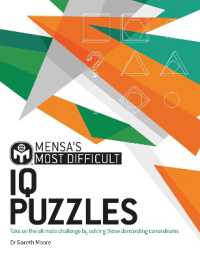- ホーム
- > 洋書
- > 英文書
- > Psychology
Full Description
In the Third Edition of the topically organized Child DevelopmentActive Learning Approach, authors Laura E. Levine and Joyce A. Munsch invite students to take an active journey toward understanding the latest findings from the field of child development. Using robust pedagogical tools built into the chapter narratives, students are challenged to confront myths and misconceptions, participate in real-world activities with children and independently, and utilize video resources and research tools to pursue knowledge and develop critical thinking skills on their own.This new edition covers the latest findings on developmental neuroscience, positive youth development, the role of fathers, and more, with topics of diversity and culture integrated throughout. More than a textbook, this one-of-a-kind resource will continue to serve students as they go on to graduate studies, to work with children and adolescents professionally, and to care for children of their own.
Contents
PrefaceAbout the AuthorsPART I. UNDERSTANDING DEVELOPMENTWE STUDY CHILDREN AND ADOLESCENTS1. Issues and Themes in Child Development Why Study Child Development? Understanding How Development Happens Contexts of Development Being a Smart Consumer of Information About Development2. Theories of Development Basic Principles and Applications Theories of Child and Adolescent Development The Impact of Biology and Culture on Child Development Theory and Research3. How We Study Development The Scientific Method How Research Is Designed Interpreting and Communicating the Results of a Study Ethics in Research With Children and AdolescentsPART II. BIOLOGICAL BEGINNINGS AND PHYSICAL DEVELOPMENT4. How Children Develop: Nature Through Nurture The Study of Genetics and Behavior Molecular Genetics: Chromosomes, Genes, and DNA Genetic Disorders Behavioral Genetics The Interaction of Genes and Environment5. Prenatal Development, the Newborn, and the Transition to Parenthood Prenatal Development Health and Risks in Pregnancy The Birth Experience Risks to the Newborn's Health and Well-Being The Transition to Parenthood6. Physical Development: The Brain and the Body Brain Development Development of the Senses Body Growth and Changes Motor Development NutritionPART III. COGNITIVE DEVELOPMENT7. Theories of Cognitive Development Piaget's Theory of Cognitive Development Theory of Core Knowledge Vygotsky's Sociocultural Theory of Cognitive Development Information Processing Comparing Four Theories of Cognitive Development8. Intelligence and Academic Achievement Defining and Assessing Intelligence Variations in Intellectual Ability Academic Achievement: Learning in the School Context Group Differences in Academic Achievement9. Language Development Aspects of Language Language and the Brain Theories of Language Development Stages of Language Development Literacy: Reading and Writing Bilingualism and Bilingual Education Language DisordersPART IV. SOCIAL AND EMOTIONAL DEVELOPMENT10. Emotional Development and Attachment Emotions: Universality and Difference Temperament Regulation of Emotions and Self-Control Normal Emotions and Emotional Problems The Development of Secure Attachment Attachment Disorders11. Identity: The Self, Gender, and Moral Development Development of the Self-Concept Development of Self-Esteem Gender Identity Ethnic and Racial Identity Moral Identity12. Social Development: Social Cognition and Peer Relationships Social Cognition: Theory of Mind Peer Relationships in Infancy and Early Childhood Peer Relationships in Middle Childhood Adolescents: The World of Peers Bullying, Cyberbullying, and School ViolencePART V. CONTEXTS FOR DEVELOPMENT13. Families What Constitutes a Family? Family Roles and Relationships Socialization in Childhood and Adolescence Interventions for a Better Family Life14. Activities, Media, and the Natural World The Daily Lives of Children and Adolescents Unstructured Time Structured Time The Role of Important Nonparental Adults15. Health, Well-Being, and Resilience Stress and Coping Physical Illness and Mental Disorders Other Threats to Health and Well-Being Challenges to Positive Child Development ResilienceGlossaryReferencesAuthor IndexSubject Index







